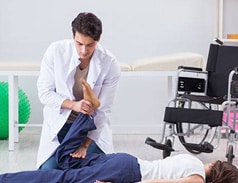Hi, I’m Anna, Remedial Massage Therapist at Miami Physiotherapy. We treat everything from arthritis to pulled muscles to inflammation with ice or hot packs.
Treating pain with hot and cold can be extremely effective and easily affordable. The tricky part is knowing what situation calls for hot, and which calls for cold. Sometimes a single treatment will even include both.
Heat Therapy
Heat is for muscles, chronic pain, and stress. Back pain particularly often involves lots of tension, anxiety and sensitization of the nerves. Comfortable heat can soothe your jangled mind, tight muscles and stressed nervous system.
When to use heat therapy
Use heat therapy before doing stretches, Foam roller or spiky ball. The heat will warm up and soften the muscle so you can go further with the stretches and deeper with the foam roller and spiky ball, feeling less pain.
Types of Heat: heating pads, packs or wraps, hot water bottles, saunas, steamed towels or hot baths.
When not to use heat therapy
If you are pregnant, saunas and hot baths are not suitable and heat packs should not be applied to the abdomen. Seek advice before using heat therapies.
Do not use heat on acute injuries because that extra heat can increase inflammation and delay proper healing.
If you experience increased swelling, stop the treatment immediately.
People with certain pre-existing conditions should not use heat therapy due to higher risk of burns or complications due to heat application. These conditions include:
- Diabetes,
- Dermatitis,
- Vascular diseases,
- Deep vein thrombosis,
- Multiple Sclerosis (MS),
- Infections, and
- Pregnancy
How to apply heat packs
Wrap the heat pack in a thin towel to help protect your skin. Apply to the painful area for up to 20 minutes, several times each day.
Cold Therapy
The chill constricts blood vessels which numbs pain, relieves inflammation and limits bruising. Icing is mostly just a mild, drugless way of dulling the pain of inflammation and hopefully taking swelling down a bit.
When to use cold therapy
When dealing with injuries, it’s best to predominantly choose ice if the injury is acute (less than 6 weeks old).
Types of cold therapy: ice packs or frozen gel packs, coolant sprays, ice baths.
When not to use cold therapy
People with sensory disorders that prevent them from feeling certain sensations should not use cold therapy at home because they may not be able to feel if damage is being done. This includes diabetes and people with poor circulation.
How to apply ice packs
For home treatment, apply an ice pack wrapped in a towel or ice bath to the affected area. You should never apply a frozen item directly to the skin, as it can cause damage to the skin and tissues. Apply cold treatment as soon as possible after an injury.
Use cold therapy for short periods of time, several times a day. Ten to 15 minutes is fine, and no more than 20 minutes of cold therapy should be used at a time to prevent nerve, tissue, and skin damage. You can elevate the affected area for best results.
Using heat and cold therapy together
Alternating between applications of ice and heat is called contrasting therapy or contrast baths. It’s extremely stimulating and is mostly used to facilitate injury recovery as well as reducing pain and swelling in arthritis.
Conclusion
As a general rule of thumb, use ice for acute injuries or pain, along with inflammation and swelling. Use heat for muscle pain or stiffness.
The bottom line is: use whatever feels best to you!
Your own preference is the tie-breaker and probably the most important consideration. For instance, heat cannot help if you already feel unpleasantly flushed and don’t want to be heated. And ice is unlikely to be effective if you have a chill and hate the idea of being iced!
Whether you use heat or cold, be sure to wrap the pack in a thin towel to help protect your skin.
Apply to the painful area for around 20 minutes several times each day.
If you are not sure of the right treatment for your aches, pain or injury – come and see our therapy team at Miami Physiotherapy or Lakelands Physiotherapy.

